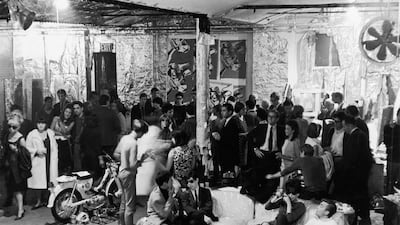“I just got a message that said ‘Popcorn’ so I came,” an excited voice shrieks above the noise of the crowd that’s gathered in the Art Gallery at NYU Abu Dhabi.
The smell of popcorn is indeed unmistakeable; hot dogs are also being served and a DJ is spinning tunes by David Bowie and Stevie Wonder. In other words, there’s a party going on, despite the fact that it’s only 7pm, and what’s more it’s a party with an art historical point.
Even if you’d just followed your nose without stopping to read what’s pinned to the walls and, sort of just wandered past the table piled with hats and dressing up wigs, by the time you reached the back room wallpapered in silver foil, the realisation should have hit. You’ve travelled back in time to Andy Warhol’s Factory in Manhattan and a scene that changed the art world forever.
With his almost mass-produced screenprints of famous faces, a partying entourage of musicians, actors and social outsiders, all claiming their 15-minutes of fame, the elevation of ordinary household objects such as Brillo soap pad boxes and Campbell’s soup tins to “art”, and exhibition rooms dressed to look like supermarket shelves, Warhol shook a socially conservative America in the 1960s.
In a city like Abu Dhabi that’s building its own art community, the parallel with Andy Warhol’s Factory is both a fun and a useful one, says Maya Allison, founding director of the Art Gallery and chief curator at NYUAD.
“What I really want to do is get people thinking about how we are the future of our art community,” she says. “A great means to do that is to think about past art communities that have been important historically.
“And instead of thinking about it in a serious scholarly way,” Allison says, laughing, “we came up with the idea of time travel as a means to talk about moments when communities were at the centre of important art historical developments.”
The Factory night is the first in a series of ‘Art History Time Machine’ parties and an innovative way to make sure that NYUAD Art Gallery continues to be at the heart of the emirate’s conversation about art, beyond its calendar of exhibitions.
“I don’t know who or what it will be,” Allison says of the next event, which will likely take place in September, “but other examples of ‘time travel’ would be the Progressive Movement in India in the 1940s and 50s, and Paris in the 1920s. We are hoping to look eastwards for little known examples of this, as well as the more famous ones.”
The Warhol theme has drawn a mixed crowd of students, faculty staff and their children – who look the most at home in the badly cut nylon wigs not dissimilar to Warhol’s own collection – and visitors from around the city.
In the silvered room, there’s the opportunity to become a fully-fledged member of Warhol’s entourage: you can do a ‘Screen Test’, which is projected in black and white, or dress up to create your own ‘Art Star’, which is then captured for posterity on Polaroid film. The Polaroids are being pasted into a photo album each accompanied by a short biography, for future publication. It’s hoped this volume of local Art Stars will create a Warhol-like time capsule of this particular Abu Dhabi moment.
Crystal Priebe, who hails from California and works for the Cleveland Clinic, is enthused by the idea. Her animated Screen Test invokes a good response from the crowd. “I had no idea that you had to just be still,” she says, “I was talking into a banana.” It’s a Warhol banana though so that’s OK, I reassure her.
By the dressing up table, two NYUAD students are poised to write their Art Star biography. Why did you come tonight, I ask, before cynically suggesting that a free meal is more of a draw than the Pop Art artist. I’m quickly put in my place: one calls art her hobby and the other is a big fan of The Velvet Underground, the US rock band that briefly provided the soundtrack to Warhol’s Factory parties.
“I didn’t know that much about Warhol,” music fan Lina Elmusa says, “but I can imagine this as something that he does. It’s also really fun.” The two friends say they paused to read the notes about Warhol, his work and his enduring influence.
By 9pm, even the young man in sunglassses who bears a passing resemblance to Warhol (or is that how he normally dresses?) has gone and all that remains is to guess where the next Art History Time Machine will take us.
• For future events, visit www.nyuad-artgallery.org.
Clare Dight is editor of The Review.

